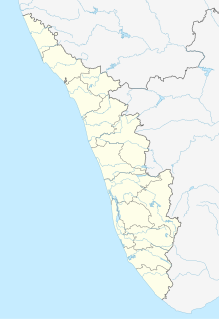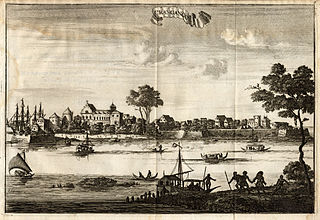
Kochi, also known as Cochin, is a major port city on the south-west coast of India bordering the Laccadive Sea a part of the Arabian Sea. It is part of the district of Ernakulam in the state of Kerala and is often referred to as Ernakulam. Kochi is the most densely populated city in Kerala. As of 2011, it has a corporation limit population of 677,381 within an area of 94.88 km² and a total urban population of more than of 2.1 million within an area of 440 km², making it the largest and the most populous metropolitan area in Kerala. Kochi city is also part of the Greater Cochin region and is classified as a Tier-II city by the Government of India. The civic body that governs the city is the Kochi Municipal Corporation, which was constituted in the year 1967, and the statutory bodies that oversee its development are the Greater Cochin Development Authority (GCDA) and the Goshree Islands Development Authority (GIDA).

The Kingdom of Travancore was an Indian kingdom from c. 1729 until 1949. It was ruled by the Travancore Royal Family from Padmanabhapuram, and later Thiruvananthapuram. At its zenith, the kingdom covered most of modern-day southern Kerala, parts of central Kerala, and the southernmost part of modern-day Tamil Nadu with the Thachudaya Kaimal's enclave of Irinjalakuda Koodalmanikyam temple in the neighbouring Kingdom of Cochin.

Cochin Jews are the oldest group of Jews in India, with roots that are claimed to date back to the time of King Solomon. The Cochin Jews settled in the Kingdom of Cochin in South India, now part of the state of Kerala. As early as the 12th century, mention is made of the Jews in southern India. The Jewish traveler Benjamin of Tudela, speaking of Kollam (Quilon) on the Malabar Coast, writes in his Itinerary:
"...throughout the island, including all the towns thereof, live several thousand Israelites. The inhabitants are all black, and the Jews also. The latter are good and benevolent. They know the law of Moses and the prophets, and to a small extent the Talmud and Halacha."

Cochin International Airport is an international airport serving the city of Kochi, in the state of Kerala, India. Located at Nedumbassery, about 25 kilometres (16 mi) northeast of the city, Cochin International Airport is first of its kind which is developed under a public-private partnership (PPP) model in India. This project was funded by nearly 10,000 non-resident Indians from 30 countries.

Kodungallur is a historically significant town and a municipality on the banks of river Periyar on the Malabar Coast in Thrissur district of Kerala, India. It is situated 29 kilometres (18 mi) north of Kochi (Cochin) by National Highway 66. Kodungallur, being a port city at the northern end of the Kerala lagoons, was a strategic entry point for the naval fleets to the extensive Kerala backwaters.

Kingdom of Cochin was a late medieval kingdom and later princely state on the Malabar Coast, South India. Once controlling much of the territory between Ponnani and Thottappally, the Cochin kingdom shrank to its minimal extent as a result of invasions by the Zamorin of Calicut. When Portuguese armadas arrived in India, the Kingdom of Cochin had lost its vassals like Edapalli, Cranganore etc. to the Zamorin and was looking for an opportunity to preserve the independence of Cochin which was at risk. King Unni Goda Varma warmly welcomed Pedro Álvares Cabral on 24 December 1500 and negotiated a treaty of alliance between Portugal and the Cochin kingdom, directed against the Zamorin of Calicut. Cochin became a long-time Portuguese ally (1503–1663) providing assistance against native overlords. After the Portuguese, the Dutch East India Company (1663–1795) was an ally of Cochin. This was followed by the English East India Company, having suzerainty over the Cochin state.

Travancore–Cochin or Thiru–Kochi was a short-lived state of India (1949–1956). It was originally called United State of Travancore and Cochin and was created on 1 July 1949 by the merger of two former kingdoms, Travancore and Cochin with Thiruvananthapuram as the capital. It was renamed State of Travancore–Cochin in January 1950.

The Cochin is a breed of large domestic chicken. It derives from large feather-legged chickens brought from China to Europe and North America in the 1840s and 1850s. It is reared principally for exhibition. It was formerly known as Cochin-China.

Padmanabhapuram is a town and a municipality near Thuckalay in Kanyakumari district in the Indian state of Tamil Nadu. As of 2011, the town had a population of 21,342.

Thrippunithura or Tripunithura is a prominent historical and residential region in the city of Kochi in Kerala, India. Located about 7 km (4 mi) from the city centre, Tripunithura was the capital of the erstwhile Kingdom of Cochin. The descendants of the Cochin royal family still live here. The Hill Palace situated in Tripunithura was the palace of Maharaja of Cochin, the ruler of Kingdom of Cochin. Tripunithura is also well known for its historical cultures and worldwide famous because of Sree Poornathrayeesa Temple and the annual festival Vrishchikoltsawam that takes place at the temple.

The Pekin Bantam is a British breed of bantam chicken. It derives from birds brought to Europe from China in the nineteenth century, and is named for the city of Peking where it was believed to have originated. It is a true bantam, with no corresponding large fowl. It is recognised only in the United Kingdom, where the Cochin has no recognised bantam version; like the Cochin, it has heavy feathering to the legs and feet. The Entente Européenne treats the Pekin Bantam as equivalent to the bantam Cochin.

The High Court of Kerala is the highest court in the Indian state of Kerala and in the Union Territory of Lakshadweep. It is located in Kochi. Drawing its powers under Article 226 of the Constitution of India, the High Court has the power to issue directions, orders and writs including the writs of habeas corpus, mandamus, prohibition, quo warranto and certiorari for ensuring the enforcement of the Fundamental Rights guaranteed by the Constitution to citizens or for other specified purposes. The High Court is empowered with original, appellate and revisional jurisdiction in civil as well as criminal matters, and the power to answer references to it under some statutes. The High Court has the superintendence and visitorial jurisdiction over all courts and tribunals of inferior jurisdiction covered under its territorial jurisdiction.

Rama Varma Kunhjippilla Thampuran (1751–1805), or Rama Varma IX, popularly known as Sakthan Thampuran, was the ruler of the Kingdom of Cochin. He was the King of the present-day southern Indian city of Kochi and his palace was in Thrissur, which was a part of the Kingdom of Cochin. The city of Thrissur is referred to as the Cultural Capital of Kerala owing to its many traditional festivals and historic temples. Sakthan Thampuran is considered the architect of the city of Thrissur. The festival Thrissur Pooram is considered to have been first started by him.

The Mattancherry Palace is a Portuguese palace popularly known as the Dutch Palace, in Mattancherry, Kochi, in the Indian state of Kerala which features Kerala murals depicting portraits and exhibits of the Rajas of Kochi. The palace was included in the "tentative list" of UNESCO World Heritage Site.

Chittur is a green town in Palakkad district of Kerala, South India. It is the headquarters of Chittur taluk, situated 13 km away from Palakkad towards the south-east, on the banks of Kannadipuzha, a major headstream of Bharathapuzha, the second longest river in Kerala. It was once part of the erstwhile Kingdom of Cochin.

The Kochi metropolitan area or Kochi urban agglomeration is a metropolitan area centered around the city of Kochi, in Ernakulam district, Kerala, India. With a population of more than 2.1 million within an area of 440 km², it is the largest and most populous metropolitan area in Kerala.

Thrissur is the administrative capital of Thrissur District situated in the central part of Kerala state, India. Thrissur district was formed on 1 July 1949. It is an important cultural centre, and is known as the Cultural Capital of Kerala. It is famous for the Thrissur Pooram festival, one of the most colourful and spectacular temple festival of Kerala. From ancient times, Thrissur has played a significant part in the political, economical and cultural history of Indian sub continent and South East Asia. It has opened the gates for Arabs, Romans, Portuguese, Dutch and English. Thrissur is where Christianity, Islam and Judaism entered the Indian sub continent, when Thomas the Apostle arrived in 52 CE and the location of country's first Mosque in the 7th century.

Hill Palace is an archaeological museum and palace located in the Tripunithura neighbourhood of Kochi city in the Indian state of Kerala. It is the largest archeological museum in the state and was the imperial administrative office and official residence of the Cochin Maharaja. Built in 1865, the palace complex consists of 49 buildings in the traditional architectural style, spreading across 54 acres (220,000 m2). The complex has an archaeological museum, a heritage museum, a deer park, a pre-historic park and a children’s park. The campus of the museum is home to several rare species of medicinal plants. Presently the palace has been converted into a museum by The Kerala State Archaeology Department and is open to public. The palace is about 10 kilometres (6.2 mi) from the city centre and is approachable by road and rail.

Dutch Malabar, also known by the name of its main settlement Cochin, was the title of a commandment of the Dutch East India Company on the Malabar Coast between 1661 and 1795, and is part of what is today collectively referred to as Dutch India. Dutch presence in the region started with the capture of Portuguese Quilon, and ended with the occupation of Malabar by the British in 1795. They possessed military outposts in 11 locations: Alleppey, Ayacotta, Chendamangalam, Pappinivattom, Ponnani, Pallipuram, Cranganore, Chetwai, Cannanore, Cochin, and Quilon.
Events from the year 1503 in India. 13rsrichar


















